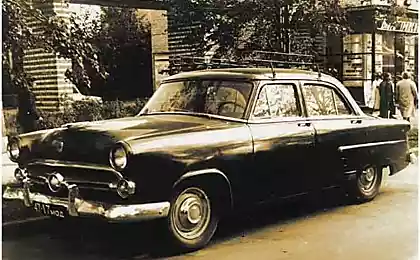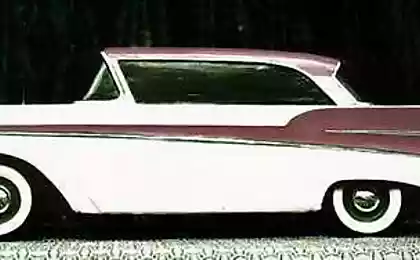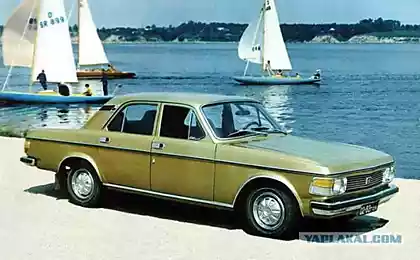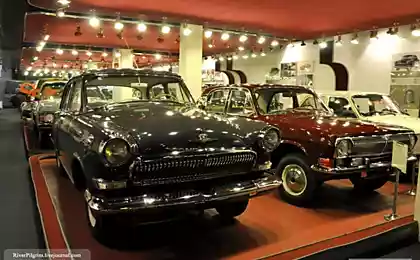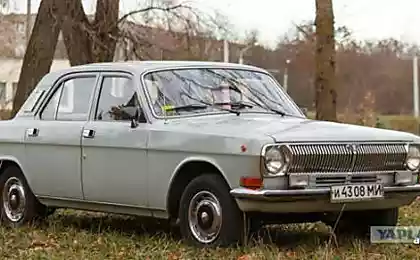880
Remembering ... Volga - a car elite
1970 Year ... The head of the district department of the pension fund in the regional center of H and could not dream of a Mercedes S-Class, as the police chief of the Porsche Cayenne or Reynzh Rover Sport ... within their dream was just appearing on the roads of the country's new "Volga" .
Ensued a classic GAZ-21, a spokeswoman for the American automotive school for many years shaped the Soviet cities, becoming the "official carrier" managers and supervisors of all ranks, as well as fill in numerous taxis.
There was even a tacit classification of "Volga" depending on the color: yellow - for taxis, gray, blue-gray and beige - to lower management or rare privateers, white - for middle managers, black - for the elite (party and business). < br />
Today, meet on the road "Volga" GAZ-24 can be quite rare, especially because it was amazing to see the car on the street, though he had just descended conveyor Gorky Automobile Plant ...
11 photos and some text. Source

2. Thus, the GAZ-24. The legendary Soviet car, released in quantities of 1, 5 million copies, became the dream of every motorist (steeper were the only foreign cars) and became one of the stars of the Soviet cinema screen.
Develop successor to the previous model GAZ-21 began in 1961, but the final form of the model was formed only in 1965.
The first experimental batch of 32 "Volga" GAZ-24 was collected in 1968, which can be considered the birth year of "Volga". In 1969 at the Gorky Automobile Plant has released 215 cars, and the end of the year, it was finally launched pipeline.
Throughout his release "Volga" GAZ-24 significantly upgraded twice - in 1976-1978 and 1985-1987. First modernization is, in fact, facelift, when the bumper appeared typical fangs, fog lamps in the front bumper, rear lights with integrated reflectors, etc., and the second modernization has become more profound, after which the car has received index GAS 24-10.
Total from 1970 to 1992 was released 1481561 copy of the "Volga" GAZ-24, which came to replace the Model 31029.

3. The picture is still the first instance, dofeysliftingovoy series, judging by the lack of fangs on the bumper.
The design of the car was fairly standard for the turn of the sixties and seventies. For general proportions and contours of the body car was closer to American models, but detailing - bumpers, lighting fixtures - was more European. Designed in parallel with the "Volga" generation models of the European market were produced with minimal changes until the mid-1970s, and North - by the end of the decade, so that before that date "Volga" looked quite appropriate in a stream of cars in developed countries.
For 1970 GAZ-24 was a modern car, a little inferior to their American counterparts. European counterparts as the GAZ-24 were expensive and prestigious business class car like the Mercedes-Benz W114 or Opel Kapitän / Admiral / Diplomat and obviously superior "Volga" technically.

4. By the way, in the seventies and partly eighties "Volga" GAZ-24 in mass quantities (of the order of several tens of thousands per year) was delivered in dozens of countries, including industrialized, in the form of finished vehicles, and in the form of kits for "otvёrtochnoy" assembly.
Interestingly, the most popular in Europe was the "Volga" with imported diesel engines. For countries with left-hand traffic (Indonesia, India and others) produces a special modification of the right-hand drive. In addition to installing the engines, foreign dealers often change the appearance and design of car interior, bringing them to the level of the more expensive European cars.
The main advantages of the "Volga" in Western markets were a great size with a relatively low price for this class, as well as the good reputation of the previous model - GAZ-21.
In socialist countries, the GAZ-24 for most of its release was the most prestigious of the population officially sold machine except cars. But mostly the "Volga", as in the USSR, were distributed among government agencies as a personal transport government officials and used taxis.
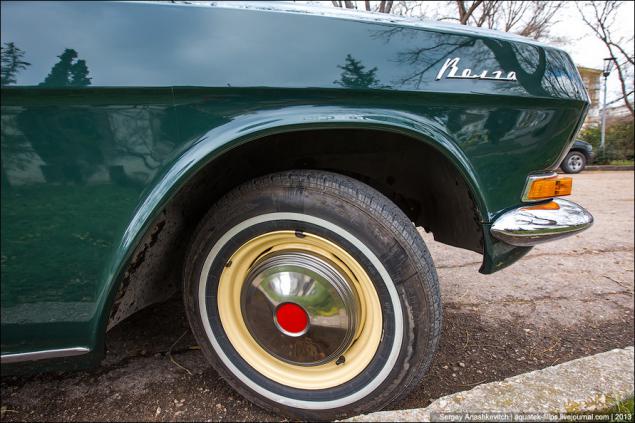
5. The famous chrome nameplate on the front wing, "Volga»

6. copy of the author Seen under the windshield contains pass inspection with the number "70". It is difficult to say whether or not he is a native. If the mother, then the car is one of the most experienced 32 issued in 1968. Go, it's probably not the case.

7. What is the mirror !!!
"Volga" from the factory was completed outside chrome rear view mirror - one on the driver's door, the second mirror on the right doors are installed only on the wagons (now the right chrome mirror - a rarity among collectors) and the antenna power extendable-retract, situated in the right wing ( see previous photo).

8. Trim modest and almost ascetic.
Controls are unusual and are consistent with the fashion of the era, with primarily American: switches the light, "stove", a washer with wiper (suction type) and "choke" arranged in a row on the left and right of the steering wheel, handbrake lever is located under the dashboard , the gas pedal - Outdoor switch passing / driving lamp - on the floor beneath the driver's left foot.
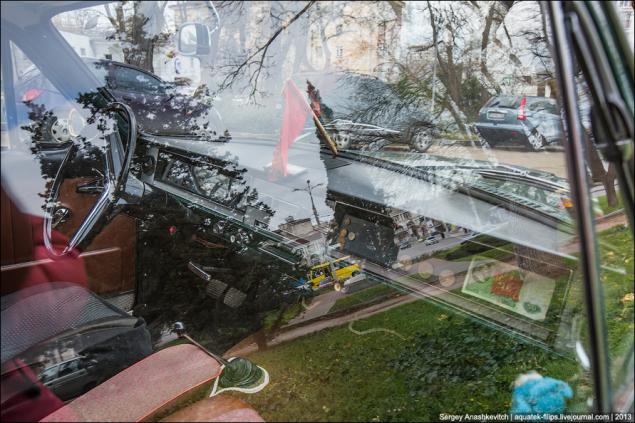
9. A under the rear window - a real exhibition of the Soviet era. Occasional kit, old magazines, radio ... Only a soccer ball and a pair of pads is not enough for a full entourage.

10. Well, of course, the tourist circuit Crimea !!!
Go to the "Volga" in the Crimea! Luxury vacation)

11. This is such an amazing instance of the author accidentally caught the eye.
Thank you for your attention!
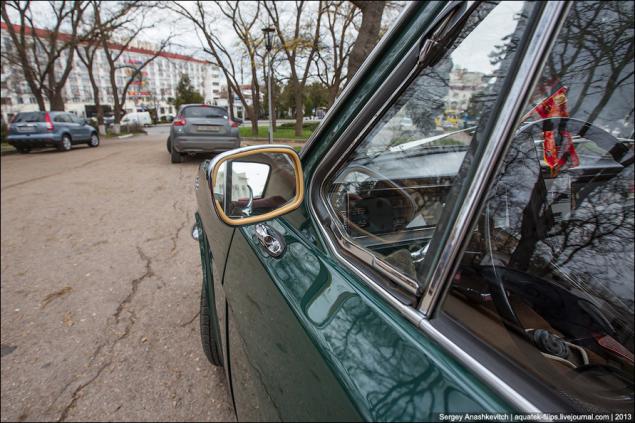
Source:
Ensued a classic GAZ-21, a spokeswoman for the American automotive school for many years shaped the Soviet cities, becoming the "official carrier" managers and supervisors of all ranks, as well as fill in numerous taxis.
There was even a tacit classification of "Volga" depending on the color: yellow - for taxis, gray, blue-gray and beige - to lower management or rare privateers, white - for middle managers, black - for the elite (party and business). < br />
Today, meet on the road "Volga" GAZ-24 can be quite rare, especially because it was amazing to see the car on the street, though he had just descended conveyor Gorky Automobile Plant ...
11 photos and some text. Source

2. Thus, the GAZ-24. The legendary Soviet car, released in quantities of 1, 5 million copies, became the dream of every motorist (steeper were the only foreign cars) and became one of the stars of the Soviet cinema screen.
Develop successor to the previous model GAZ-21 began in 1961, but the final form of the model was formed only in 1965.
The first experimental batch of 32 "Volga" GAZ-24 was collected in 1968, which can be considered the birth year of "Volga". In 1969 at the Gorky Automobile Plant has released 215 cars, and the end of the year, it was finally launched pipeline.
Throughout his release "Volga" GAZ-24 significantly upgraded twice - in 1976-1978 and 1985-1987. First modernization is, in fact, facelift, when the bumper appeared typical fangs, fog lamps in the front bumper, rear lights with integrated reflectors, etc., and the second modernization has become more profound, after which the car has received index GAS 24-10.
Total from 1970 to 1992 was released 1481561 copy of the "Volga" GAZ-24, which came to replace the Model 31029.

3. The picture is still the first instance, dofeysliftingovoy series, judging by the lack of fangs on the bumper.
The design of the car was fairly standard for the turn of the sixties and seventies. For general proportions and contours of the body car was closer to American models, but detailing - bumpers, lighting fixtures - was more European. Designed in parallel with the "Volga" generation models of the European market were produced with minimal changes until the mid-1970s, and North - by the end of the decade, so that before that date "Volga" looked quite appropriate in a stream of cars in developed countries.
For 1970 GAZ-24 was a modern car, a little inferior to their American counterparts. European counterparts as the GAZ-24 were expensive and prestigious business class car like the Mercedes-Benz W114 or Opel Kapitän / Admiral / Diplomat and obviously superior "Volga" technically.

4. By the way, in the seventies and partly eighties "Volga" GAZ-24 in mass quantities (of the order of several tens of thousands per year) was delivered in dozens of countries, including industrialized, in the form of finished vehicles, and in the form of kits for "otvёrtochnoy" assembly.
Interestingly, the most popular in Europe was the "Volga" with imported diesel engines. For countries with left-hand traffic (Indonesia, India and others) produces a special modification of the right-hand drive. In addition to installing the engines, foreign dealers often change the appearance and design of car interior, bringing them to the level of the more expensive European cars.
The main advantages of the "Volga" in Western markets were a great size with a relatively low price for this class, as well as the good reputation of the previous model - GAZ-21.
In socialist countries, the GAZ-24 for most of its release was the most prestigious of the population officially sold machine except cars. But mostly the "Volga", as in the USSR, were distributed among government agencies as a personal transport government officials and used taxis.

5. The famous chrome nameplate on the front wing, "Volga»

6. copy of the author Seen under the windshield contains pass inspection with the number "70". It is difficult to say whether or not he is a native. If the mother, then the car is one of the most experienced 32 issued in 1968. Go, it's probably not the case.

7. What is the mirror !!!
"Volga" from the factory was completed outside chrome rear view mirror - one on the driver's door, the second mirror on the right doors are installed only on the wagons (now the right chrome mirror - a rarity among collectors) and the antenna power extendable-retract, situated in the right wing ( see previous photo).

8. Trim modest and almost ascetic.
Controls are unusual and are consistent with the fashion of the era, with primarily American: switches the light, "stove", a washer with wiper (suction type) and "choke" arranged in a row on the left and right of the steering wheel, handbrake lever is located under the dashboard , the gas pedal - Outdoor switch passing / driving lamp - on the floor beneath the driver's left foot.

9. A under the rear window - a real exhibition of the Soviet era. Occasional kit, old magazines, radio ... Only a soccer ball and a pair of pads is not enough for a full entourage.

10. Well, of course, the tourist circuit Crimea !!!
Go to the "Volga" in the Crimea! Luxury vacation)

11. This is such an amazing instance of the author accidentally caught the eye.
Thank you for your attention!

Source:
The court found the slogan "Russian does not drink" extremist
The feeling of pity disappeared somewhere




